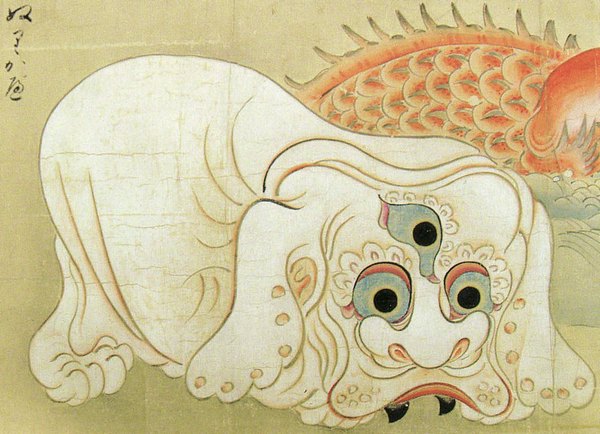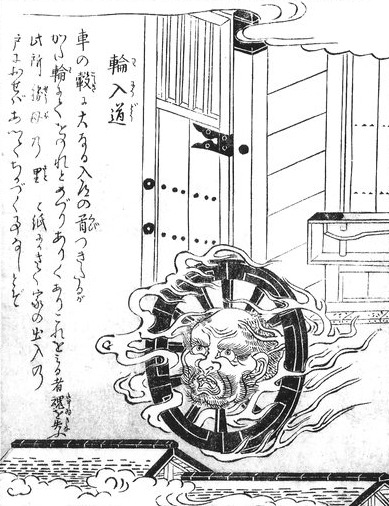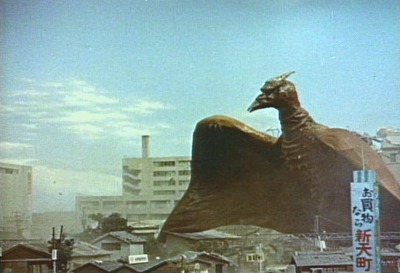Monsters – the Ultimate Adversary?
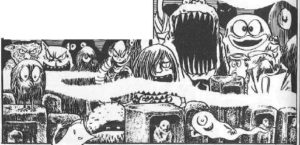
It seems to be the most gripping kind of tale: The fight against a monster. Our heroes may confront it literally, as a demonic creature or a mad serial killer, or more symbolically, in the faceless grinding mechanisms of society, or the depths of their own subconscious.
The Japanese monsters categorized as yōkai are fascinating to me, not only because of their ever-changing appearance and narratives but also for their function in cultural discourse. A couple of years ago, I wrote an essay about the classic Yōkai daisensō, “Great Yōkai War”-chapter in Mizuki Shigeru’s manga Gegege no Kitarō, and while the material in doubtlessly somewhat dated now, I still consider it interesting enough to bear retelling in this blog.
The Father of Modern Monster Manga
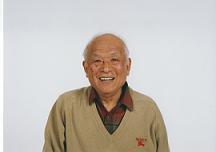
Mizuki Shigeru was one of the most influential mangaka of the 20th century. He was born as Mura Shigeru in 1924, most likely in Ōsaka,[1] and grew up in the remote town of Sakaiminato (“border harbour”) which faces the Sea of Japan. In his own autobiographical stories, he marks two eras of his life as most important: Firstly, his childhood, when an old woman told him stories about yōkai and thus built the foundation of his lifelong attention to them. Secondly, his war experiences, especially the time he spent convalescing in the village of Rabaul in Papua New Guinea after the loss of his left arm. In his works, he often idealizes the life of the natives: “as if I had somehow come upon a fairyland”[2]. Besides the spooky stories about Gegege no Kitarō, see below, Mizuki also illustrated numerous yōkai, some of which he invented or gave physical appearance for the first time. He also created a number of influential autobiographical narratives and the award-winning Showa: A History of Japan.[3] Mizuki was active as an artist far into old age; he died in November 2015. It is a great regret of mine that I never managed to visit the museum devoted to him during my stay in Japan.
Monsters and Japanese Identity
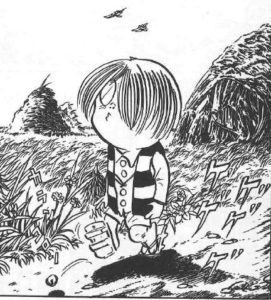
In contrast to ever-raising action levels and expectation-driven heroes who developed from the model of Tezuka Osamu’s protagonists such as Astroboy, Mizuki’s Kitarō is a more ambiguous, more laid back figure.[4] And a decidedly uncanny one, of cause. As the last descendant of a spirit tribe, Kitarō usually functions as mediator between yōkai and humans.[5] In the story Yōkai daisensō, “The Great Yōkai War” (1966), however, Kitarō allies with a group of yōkai to liberate an island from an occupation by Western monsters. This story reflects two important moments of Japanese Post-War culture and politics: The American occupation and the re-emerging discourse of Japaneseness.
A Transformation of the historical situation
In Yōkai daisensō, Mizuki addresses the real conflict of the American occupation of Japan by shifting it into a fantastic otherworld. The “monstrous” concepts of American occupation and war itself take physical form as Western monsters and thus return to the public conscious, where they can be worked through and resolved. For, as Japanese studies scholar Fabio Gygi puts it, “[t]he only way to exorcise a monster […] is to conjure it, that is, paradoxically, to make it appear”.[6] Doubly distanced in the otherworld of monsters and the island of Kikaigashima, a fictitious location at the tip of Okinawa (the very edge of Japan), the trauma becomes safe to handle. In addition, criticism of the present situation, which might be a dangerous topic in realistic works, becomes possible in a fantastic scenario.
Western Monsters as Occupation Force

Scholar of Japanese Media studies Zilia Papp analyses four approaches to the monster-war-theme in her 2009 article.[7] Regarding the Kitarō manga, she emphasizes the anti-American theme. In earlier narratives about monster wars, yōkai symbolized the alien Other, including foreigners, and were defeated by Japanese human characters.[8] By contrast, Kitarō and a band of yōkai depart to aid a child in markedly Asian dress (he is wearing a Vietnamese hat) against clearly western monsters. Thus, Mizuki uses Japanese monsters to represent the Self and “stereotypical western monsters” for the enemy. Namely, the antagonists are a witch, a wolfman, Dracula and Frankenstein’s monster, and the design of the latter two clearly alludes to American cinema.[9] In addition, “[a]nalogies to the Pacific War (1942-45), the Battle of Okinawa (1945) and the Vietnam War (1959-75) are articulated” in text and image.[10] As a result, a clear confrontation between Japanese and American representatives emerges.
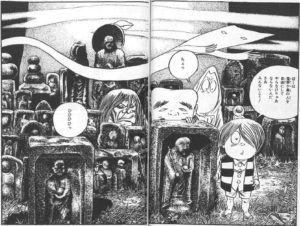
Yōkai, Japanese Monsters, as icons of Japaneseness
In her analysis of the ikai (otherworld) motif in Japanese literature of the 1990s, professor for Japanese literature Lisette Gebhardt states that an otherworld may include aspects of the alien and the afterlife. It serves as construction site for new patterns of identification.[11] In the 1960s, new identification patterns were also certainly necessary after the collapse of the military system of wartime Japan. Moreover, the development from wartime shortages and destruction to the economic growth of the 50s and 60s necessitated a redefinition of what it meant to be Japanese. This definition often arises from texts of the nihon(jin)ron or “discourse of (the) Japan(ese)”. Cultural Anthropologist Aoki Tamotsu proposes a subdivision of modern Japanese history according to the prevalent type of nihonjinron. Kitarō would fall into the early third phase, in which Japanese cultural traditions were revalidated. Fittingly, Michal Dylan Foster in his epochal study Pandemonium and Parade (2009) describes Mizuki’s works as “(re)discovery of the yōkai as pop-culture icon”.[12] Kitarō assembles yōkai from all over Japan to assist the child from the occupied island, thus his group comes to represent Japan as a whole. With their roots in local myth and folklore, yōkai are symbols of Japan in its perceived cultural uniqueness.
Monstrous Self
It is not only their clear-cut confrontation of American monster villains and Japanese yōkai which marks the latter as representatives of the Japanese (reader him/her) self. Mizuki also uses visual techniques to encourage identification with the yōkai boy Kitarō. Initially overpowered by the Western monsters, Kitarō faces the chief villain, a tentacle-sprouting, floating, one-eyed creature named Beādo.[13] In this scene, Kitarō’s pitiful state is evident in the loss of this hair and his ancestral vest Chanchanko, two of his usually effective weapons. This alone activates the reader’s sympathy and thus identification.
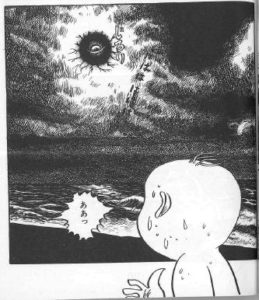
Moreover, he is positioned with his back to the reader in a pose used to provoke identification at least since Caspar David Friedrich’s romantic landscape paintings. We look over his shoulder and share his perception. The well-known manga Akira (Ōtomo Katsuhiro, 1982-90) also uses this method, as manga scholar Miriam Brunner describes. “His body protrudes […] into the picture and invites the viewer’s identification […]. Passing beyond his upper body, the recipient’s eye is guided”[14] toward the panel focus, in this case the looming figure of Beādo. Mizuki is usually very conventional with his panel designs. Therefore, it is noteworthy that this panel is the only instance in Yōkai daisensō where a character stands completely outside his panel and as close as possible to the reader. Mizuki thereby emphasizes the equation of yōkai and Japanese reader in this moment of failure and helplessness before an overpowering Western force. This of course makes the final triumph of the yōkai all the sweeter.
Nostalgia for a phantom
Mizuki reworks past trauma and present distress in a fantastic realm. His reference to ancient yōkai folklore is an emphasis of cultural tradition which can be contextualized in the search for a new identity after defeat and rapid economic growth. In so doing, he also gives form to a yearning for a less complex, less globalized world; a ‘truly Japanese’ world untainted by both war and westernization. Foster describes this emotional state as one of melancholy desire: “nostalgia might be characterized as a longing for a past (time, place, self) that is impossible to (re)claim because it no longer exists or, more likely, never did.”[15] The fantasy of a magical Japan populated by yōkai satisfies this yearning for an unalienated home.
Final Remarks
The manga confronts and works through past and present political and cultural crises, while at the same time it supports the formation of a positive consciousness of Japaneseness through fantastic nostalgia. In this way, the Great Yōkai War illustrates a specific moment in Japanese cultural history and history of thought.
Notes and References
[1] Foster, Michael Dylan (2008): “The Otherworlds of Mizuki Shigeru”. In: Mechademia 3, 8–28. 12.
[2] Mizuki Shigeru, Musume ni kataru otōsan no senki, 148-149, as quoted in Foster 2008:21.
[3] Since the original writing of this essay, an English translation in 4 volumes by Zach Davisson has appeared, which ranks high on my To-Read-list. As an introduction, see his own blog about the publication of the first volume: https://hyakumonogatari.com/2013/11/04/countdown-to-mizuki-shigerus-showa-1926-1939-a-history-of-japan/
[4] The most influential German manga scholar, Jaqueline Berndt, discusses this contrast. See Berndt, Jaqueline (1995): Phänomen Manga. Comic-Kultur in Japan. Berlin: Ed. q (Japan-Edition).63-65.
[5] Some of his adventures are available in English translation, also courtesy of Mr. Davisson. When I originally wrote my essay, though, I had to work exclusively with Japanese-language material since the only available translation was a French one.
[6] Gygi, Fabio (2008): “Mnemonic Monsters. Memory, Oblivion and Continuity in Japanese Popular Culture”. In: Minikomi 75, 5-12. 6.
[7] Papp, Zilia (2009): “Monsters at War. The Great Yōkai Wars, 1968-2005”. In: Mechademia 4, S. 225–239.
[8] Papp 2009:226-7.
[9] Papp 2009:227.
[10] Papp 2009:227.
[11] Gebhardt, Lisette (1999): “Ikai. Der Diskurs zur ‘Anderen Welt’ als Manifestation der japanischen Selbstfindungs-Debatte”. In: Irmela Hijiya-Kirschnereit (ed.): Überwindung der Moderne? Japan am Ende des zwanzigsten Jahrhunderts. Frankfurt am Main: Suhrkamp, S. 146–171. 147.
[12] Foster, Michael Dylan (2009a): Pandemonium and Parade. Japanese Monsters and the Culture of Yōkai. Berkeley, Los Angeles: University of California Press. 164.
[13] This enigmatic name might refer to the pirate Blackbeard, so that the tentacle-like appendices become a beard. Alternatively, Beādo may actually be a bugbear, a folktale creature whose main purpose seems to be to frighten children. https://www.merriam-webster.com/dictionary/bugbear
[14] Brunner, Miriam (2009): Manga – die Faszination der Bilder. Darstellungsmittel und Motive. Dissertation. München: Fink. 94-5, my translation.
[15] Foster, Michael Dylan (2009b): “Haunted Travelogue. Hometowns, Ghost Towns, and Memories of War”. In: Mechademia 4, S. 164–181.176.
Manga images taken from:
Mizuki Shigeru (1996[1959-67]): Gegege no Kitarō. Complete new edition. Tōkyō: Komikkusu. (“Yōkai daisensō”, Vol. 2, 119-171.)
Other images:
Portrait of Mizuki Shigeru: https://upload.wikimedia.org/wikipedia/commons/4/4d/Shigeru_Mura_201011.jpg
